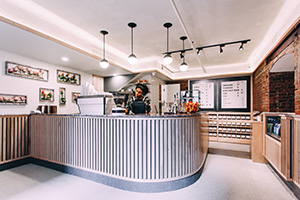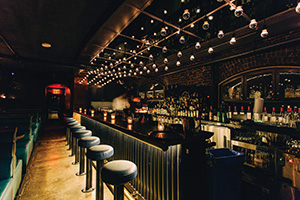Insights and issues when opening a dual-concept operation.
By Ryan McKenzie
With costs to run a successful restaurant through the roof (labor, rent and COGS — cost of goods sold — to be specific), operators are looking for any advantage they can find. The recent launch of Patent Coffee and Patent Pending in New York City provides insight into why the creative agency behind it decided to branch their first brick-and-mortar into two completely separate operations, and how you can take advantage of your space.
 Two businesses in the same location isn’t all that new — look at what Taco Bell is doing right now, selling clothing in its newest units. No matter what the reason behind the move, restaurants and retail can all agree on one thing: it’s getting harder and harder to turn a profit, so it’s best to start thinking about this as a serious option. For us, the decision to open a dual concept came down three factors: (1) high rents in Manhattan, (2) the desire to spread out risk and (3) maximizing the hours of operation.
Two businesses in the same location isn’t all that new — look at what Taco Bell is doing right now, selling clothing in its newest units. No matter what the reason behind the move, restaurants and retail can all agree on one thing: it’s getting harder and harder to turn a profit, so it’s best to start thinking about this as a serious option. For us, the decision to open a dual concept came down three factors: (1) high rents in Manhattan, (2) the desire to spread out risk and (3) maximizing the hours of operation.
We wanted to diversify Patent’s revenue stream and maximize hours of operation. For Patent, the perfect fit was to serve coffee during the daytime and shift to cocktails in the evening. So far, it’s been working. Sales are much higher than anticipated — about 20% higher. About a quarter of daily business comes from the café and the rest comes from the bar at night.
The dual concept was something that was non-negotiable. When looking at potential locations, it was important that the broker understood our needs and didn’t waste time. When a space with small frontage (400 square feet) and larger rear (600 square feet) was located, we instantly knew it was a good fit. In fact, the space had been on the market for nearly a year. It was so uniquely divided and laid out, and nobody wanted it — but it was perfect for the dual concepts of Patent Coffee and Patent Pending.
When designing the space, one thing we wanted to keep in mind was keeping the respective spaces separate. There are concepts in New York City that have done similar takes on the same theme — coffee and cocktails — but they did not separate the spaces. And although one side of the business could be very good, the other side often seemed to lag. They didn’t seem to always work well with each other. Pro tip: when designing a dual concept, you really should consider your two concepts and how they serve, who they serve, and the physical design of the space itself.
 We asked ourselves, “Does someone want to sit in a coffee shop and drink cocktails?” We concluded that, most likely, they did not. We delved into the psychology of it, and agreed that a coffee shop is a morning place, a productive place and an energetic or peaceful place. A bar is exciting, and the type of bar we wanted, it was going to be dark. We knew people didn’t want to spend time drinking coffee in a cocktail bar, and vice versa, so we completely physically separated the spaces.
We asked ourselves, “Does someone want to sit in a coffee shop and drink cocktails?” We concluded that, most likely, they did not. We delved into the psychology of it, and agreed that a coffee shop is a morning place, a productive place and an energetic or peaceful place. A bar is exciting, and the type of bar we wanted, it was going to be dark. We knew people didn’t want to spend time drinking coffee in a cocktail bar, and vice versa, so we completely physically separated the spaces.
Another thing owners have to ask themselves is if it’s a smooth fit for operations. For Patent, the primary deciding factor came down to hours of operation. Patent Coffee is open from 7:30 a.m. to 4:00 p.m., then it closes, locks the doors and has 1 hour to clean up before the cocktail bar, Patent Pending, opens to the general public. This has worked well. Operators should be considerate of factors like this: first thing, dig deep into the operations and financials and make sure you have really thought about all factors. From lease negotiations with landlords, to ensuring there is enough amperage to power the extra equipment, to budgeting for all that extra equipment, to the extra packaging and branding costs, it’s very important to have everything planned out. We estimate that our up-front costs increased by about 40% by having the extra concept. With dual-concept restaurants, construction budgets take a jump up, that’s for sure.
Now that Patent has been open for a few quarters, the gamble is starting to pay off. One hand really is washing the other. Anytime there is a big push to Patent Pending, Patent Coffee gets collateral marketing. Guests will visit the back but want to come back during the day to experience the front. It’s becoming obvious they both directly benefit off each other.
When it comes to dual-concept spaces, the results speak for themselves. If done right, you’ll be very successful.
— Ryan McKenzie is one of four partners at Simmer Group, a full-service, creative agency based in New York City and focused exclusively on the QSR and hospitality industry. Patent is its first brick-and-mortar concept and working case study. Email [email protected].
